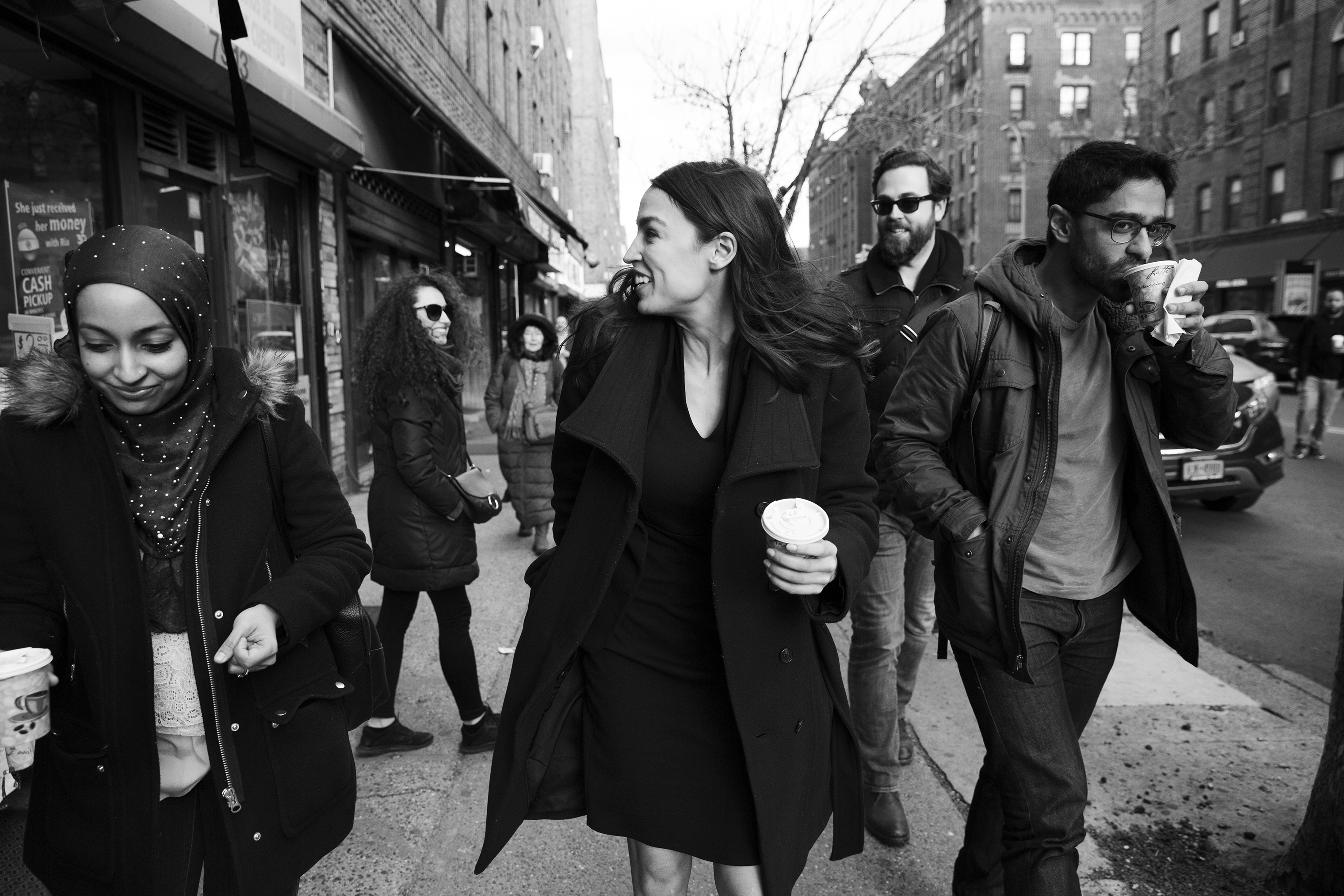Every 10 minutes or so, someone knocks on the big wooden door of Alexandria Ocasio-Cortez’s office on Capitol Hill. The noise makes staffers stiffen. It’s almost always a harmless fan, one of dozens who arrive each day, leaving neon-colored Post-it notes as devotional offerings. But in her first three months in Congress, aides say, enough people have threatened to murder Ocasio-Cortez that Capitol Police trained her staff to perform risk assessments of her visitors.
This is the daily reality for America’s newest human Rorschach test. Wonder Woman of the left, Wicked Witch of the right, Ocasio-Cortez has become the second most talked-about politician in America, after the President of the United States. Since beating 10-term incumbent Joe Crowley in the Democratic primary to represent New York’s 14th District last June, the 29-year-old former bartender has pressured 2020 presidential candidates into supporting her Green New Deal, made campaign-finance reform go viral and helped activists banish Amazon from Queens with a couple of tweets. No lawmaker in recent memory has translated so few votes into so much political and social capital so quickly. Her Twitter following has climbed from about 49,000 last summer to more than 3.5 million. Thousands of people tune in to watch her make black-bean soup or re-pot her houseplants on Instagram Live. Immediately after she tweeted the name of her signature red lipstick—Beso, by Stila—it sold out online.
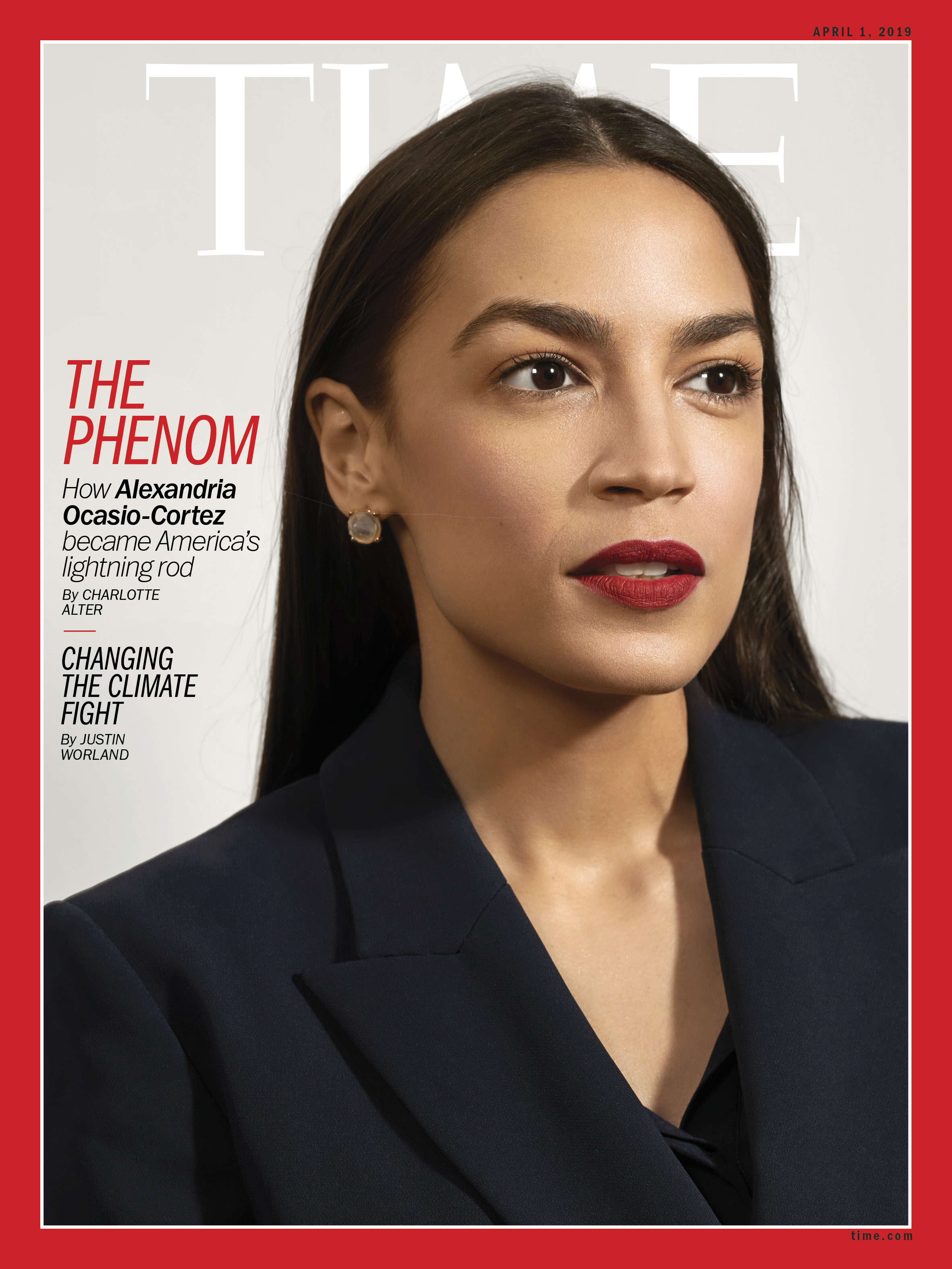
At the same time, she’s a freshman legislator trying to get the hang of her first big full-time job. “I miss being able to go outside in sweats,” she says in her office one day in March, settling into a black leather chair after a long day of subcommittee hearings. She’s much smaller than she looks on TV, with a warm but cautious manner. “I can’t go anywhere in public and just be a person without a lot of people watching everything I do.”
Ocasio-Cortez represents one vision of the Democratic Party’s future. She’s a young Hispanic woman, three cornerstones of the party’s electoral coalition. She’s a democratic socialist at a time when confidence in capitalism is declining, especially among progressive millennials. The issues she ran on—a Green New Deal, Medicare for All, a federal jobs guarantee, abolishing ICE—are animating a new generation of Democrats. She’s a political phenomenon: part activist, part legislator, arguably the best storyteller in the party since Barack Obama and perhaps the only Democrat right now with the star power to challenge President Donald Trump’s.
The woman everyone calls AOC is as much a villain to the right as she is a hero to the left. She’s replaced Hillary Clinton as the preferred punching bag of Fox News pundits and Republican lawmakers, and the hits are taking their toll. Public opinion of Ocasio-Cortez has soured as she becomes better known; according to a Gallup poll conducted in February, 31% of Americans overall have a favorable impression of her, against 41% unfavorable—a 15-point swing since September. The same poll found that her popularity had increased with Democrats and nonwhites. Her Green New Deal proposal has driven policy debates on the left, but it has virtually no chance of becoming law anytime soon. Her allies plan to boost primary challengers to moderate and conservative Democrats, a push that Ocasio–Cortez has distanced herself from but one that has earned her the enmity of some colleagues. Many House Democrats resent her celebrity and worry it overshadows efforts to reach the moderate voters who propelled the party to the majority. Privately, some admit they’re also a little afraid of her.
That’s because Ocasio-Cortez threatens the status quo, bringing a youthful impatience to a set of policies popularized by Bernie Sanders’ 2016 campaign, like Medicare for All and tuition-free public college. Like Sanders, she seems more concerned with movements than elections; she doesn’t talk about flipping seats and votes, but rather of winning hearts and minds. Hers is the politics of the possible, not the practical. “By the time legislation actually gets through, it is five years from now,” she says. “So everything we introduce needs to have 2025 or our kids in mind.” She’s not thinking about how to keep the Democratic majority for another two years; she’s thinking about how to define the agenda for the next two decades.
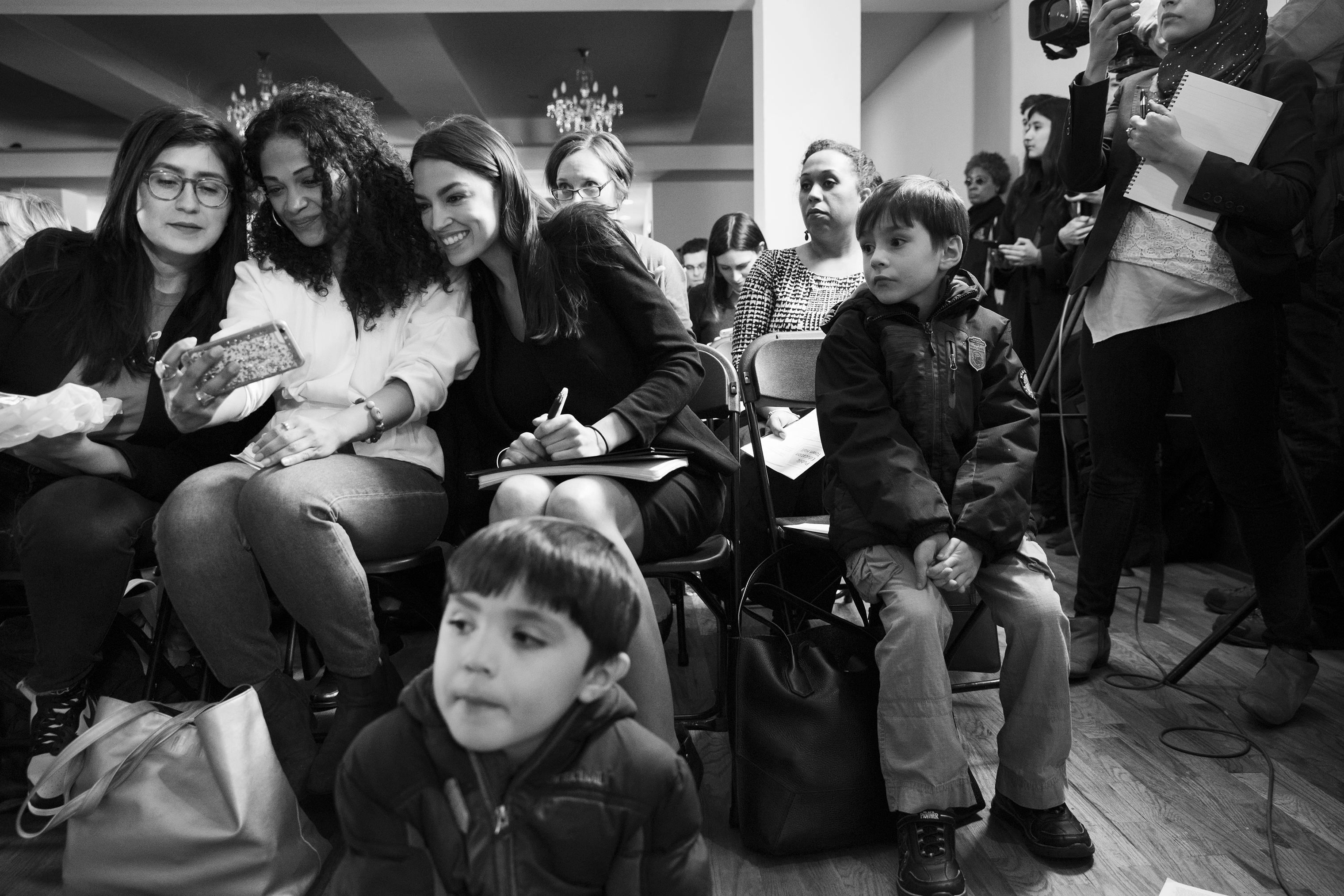
It’s a big change in a party that spent the last 10 years following incrementalist leaders like Obama and Hillary Clinton. It’s not just that Ocasio-Cortez is pushing for more progressive policies. She’s recast the division between left and center as a tug-of-war between the party’s past and its future. “There’s always this talk about division within the Democratic Party, ideological differences,” she says in her office. “But I actually think they’re generational differences. Because the America we grew up in is nothing like the America our parents or our grandparents grew up in.”

On Ocasio-Cortez’s office bookshelf, near a picture of her late father and a photo of her with a local Girl Scout troop, two books nestle together in uneasy union. One is the Federalist papers, written mostly by James Madison and Alexander Hamilton and published in 1788. The other is The Uninhabitable Earth: Life After Warming, written by journalist David Wallace-Wells 231 years later. There’s a picture of Wonder Woman leaning in one corner of the office and a giant cardboard cutout of Cardi B’s face in another. On her desk are handwritten crib sheets for a February hearing. (“I’m going to be the bad guy,” she wrote in pencil.) More than 40 million people watched a subsequent NowThis News clip of her questioning a -government-accountability watchdog about campaign-finance laws.

Ocasio-Cortez was born in 1989, a few weeks before the Berlin Wall fell. George H.W. Bush was in his first year as President, Nancy Pelosi had just gotten to Congress, Sanders had already lost two Senate races, and Joe Biden had just bungled his first presidential bid. She was in elementary school during the financial prosperity of the 1990s, eating Dunkaroos while grownups clucked on television about Bill Clinton balancing the budget. “An entire generation, which is now becoming one of the largest electorates in America, came of age and never saw American prosperity,” she says. “I have never seen that, or experienced it, really, in my adult life.”
She was born into a working-class family in the Parkchester section of the Bronx. Her dad owned a small architecture company; her Puerto Rico–born mother cleaned houses. They were deeply rooted in the neighborhood but also wary of its limitations. Ocasio-Cortez has told friends she learned early on that wearing hoop earrings and nameplate necklaces was fine in the Bronx, but she wouldn’t be taken seriously if she wore them to a job interview. The family moved to the prosperous Westchester County suburb of Yorktown Heights when she was about 5 so that she and her brother could go to better schools, but they returned frequently to see the rest of their family. Those 40-minute drives taught her how ZIP code determines destiny, she says. By the time she was in college, some of her cousins were already having kids.
Ocasio-Cortez describes herself as a “dorky kid” who once asked for a micro-scope for her birthday. Her 2007 high school microbiology project, on the effects of antioxidants on the life span of roundworms, won second place in the microbiology category at the Intel International Science and Engineering Fair. She often joined her mom to clean the homes of neighbors, and she wrote her college-application essay about the two of them helping a man who’d lost his wife the only way they could—by cleaning out his fridge. She took out student loans to enroll at Boston University, graduating in 2011 with a degree in economics and international relations.
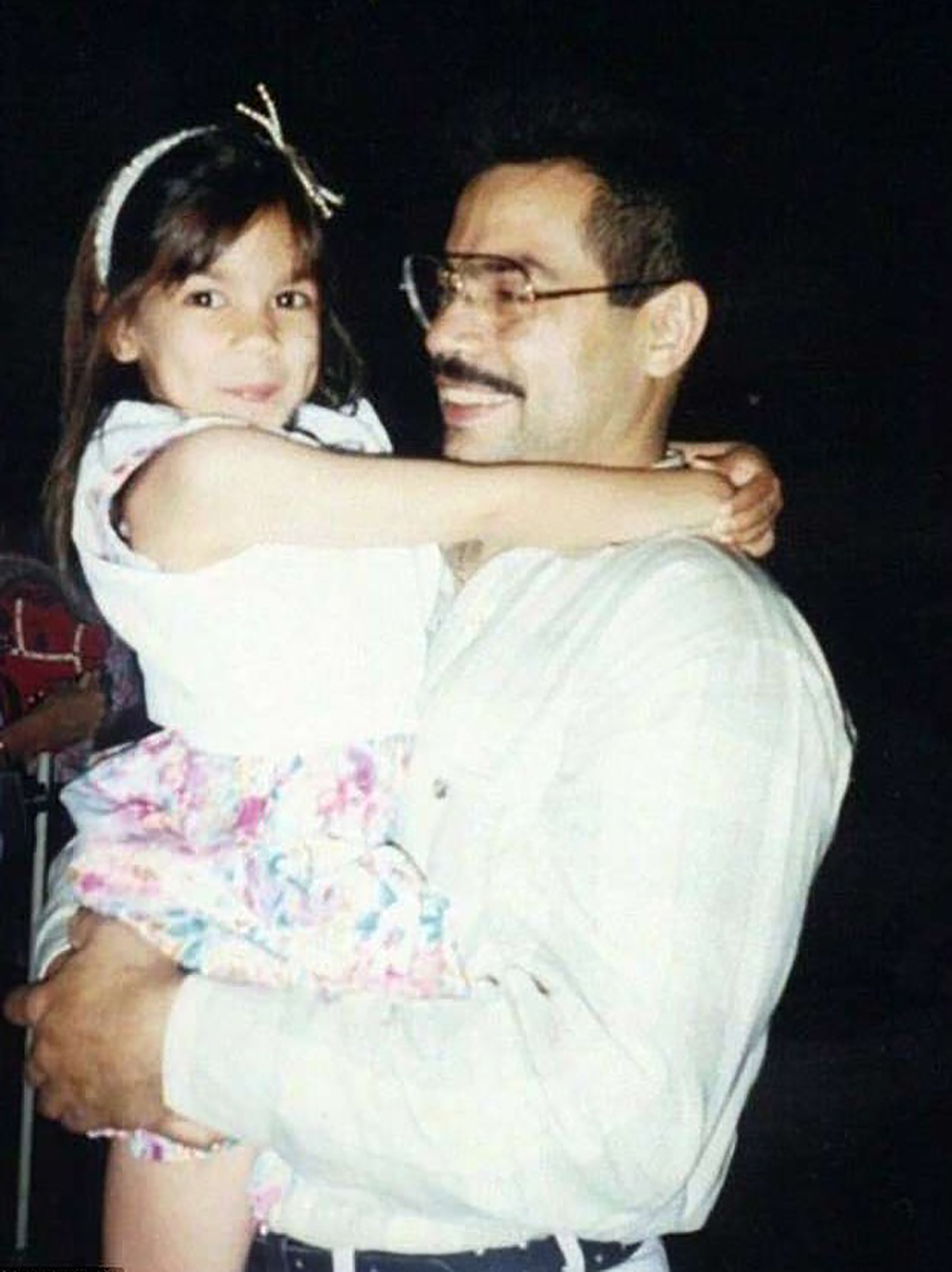
When Ocasio-Cortez was a teenager, her father was diagnosed with lung cancer. Just before she returned to Boston for her sophomore year, she went to see him in the hospital. “I didn’t know that it was going to be the last time that I talked to my dad, but toward the end of our interaction, I started to feel like it was,” she says. “I said goodbye, but I think he knew, and I knew. And so I started to leave, and he kind of hollered out, and I turned around in the doorframe, and he said, ‘Hey, make me proud.’”
He died about a week later, in the fall of 2008. The death plunged the family into financial trouble just as the economy was melting down; her mother picked up a job driving school buses to stave off foreclosure on their home. After graduation, Ocasio-Cortez moved back to the Bronx to work at an educational nonprofit, with a side gig as a bartender at a Manhattan taco joint. Most of her peers were piecing together two or three jobs to stay ahead of the bills. “Spoiler alert: the gig economy is about not giving people full-time jobs,” she says. “So it should be no secret why millennials want to decouple your insurance status from your employment status.”
For most of her 20s, she lived paycheck to paycheck. She paid $200 a month for an Affordable Care Act health insurance plan with a huge deductible. Like 44 million other Americans, she had student-loan debt: about $25,000 worth, which meant $300 a month in payments. “We have an entire generation that is delaying or forgoing purchasing houses,” she says. “Our entire economy is slowing down due to the student-loan crisis.”
Ocasio-Cortez had gotten her first taste of politics during college, as an intern in Massachusetts Senator Ted Kennedy’s office. By the time -Bernie Sanders launched his 2016 campaign, she was hooked. She volunteered to knock on doors for his campaign across the Bronx and Queens. “I had done grassroots organizing before,” she says. “But Sanders’ race was one of my first times where I crossed that bridge from grassroots community organizing to electoral organizing.”

When Trump won, Ocasio-Cortez was shocked but not surprised. In the weeks after the election, she and her friends piled into a borrowed 1998 Subaru and drove from New York City to the Standing Rock Indian Reservation to join the Lakota Sioux’s resistance to the Dakota Access Pipeline. They drove through the Midwest, stopping in Flint, Mich., on their way to the freezing plains of North Dakota. They had long bull sessions about whether Sanders would have beaten Trump and whether the media had been in the tank for Clinton. They sang TLC’s “No Scrubs” and subsisted on Red Bull, Clif Bars and Hot Cheetos from gas stations.
The Standing Rock trip was “transformational” for Ocasio-Cortez. She had visited a city poisoned by lead on her way to help a community fight the construction of a massive government-backed oil pipeline. The trip helped her “connect a lot of different dots” about how environmental degradation affects everybody, no matter where you live. “I think the me that walked out of that,” she says, “was more galvanized and more open to taking risks.”
Then, as she was driving back to New York, she got a call she never expected. Someone wanted her to run for Congress.
Once it became clear that Sanders wouldn’t win the nomination, a few of his former staffers formed a group called Brand New Congress. The goal was to recruit progressives who weren’t wealthy, well–connected white men to run for the House and Senate so that a future progressive President would have allies in the legislature. Saikat Chakrabarti, now Ocasio-Cortez’s chief of staff, and Corbin Trent, now her communications director, began soliciting names of working-class leaders who might be willing to run. In the end, they got some 11,000 nominations from across the country. One of them was a letter from Gabriel Ocasio-Cortez, 26, touting his older sister Alexandria. She fit the mold exactly. “We looked at the brother telling the story of a sister who wasn’t a giant nonprofit executive, she didn’t go work on the Hill for 10 years,” recalls Alexandra Rojas, now executive director of Justice Democrats, an organization allied with Brand New Congress. “She was someone who watched her family struggle through the financial crisis.”
The campaign was a long shot from the start. “Everyone said, ‘She’s really cute, but maybe next time,’” Ocasio-Cortez recalls. Crowley, the fourth-ranking House Democrat, was a prolific fundraiser who had been in Congress since 1999. Her campaign was mostly volunteers. Staffers wrote their job titles on Post-it notes above their desks in their small Queens office. Ever the activist, her campaign had an informal, flexible structure resembling “leaderless” social movements like the one she saw at Standing Rock.
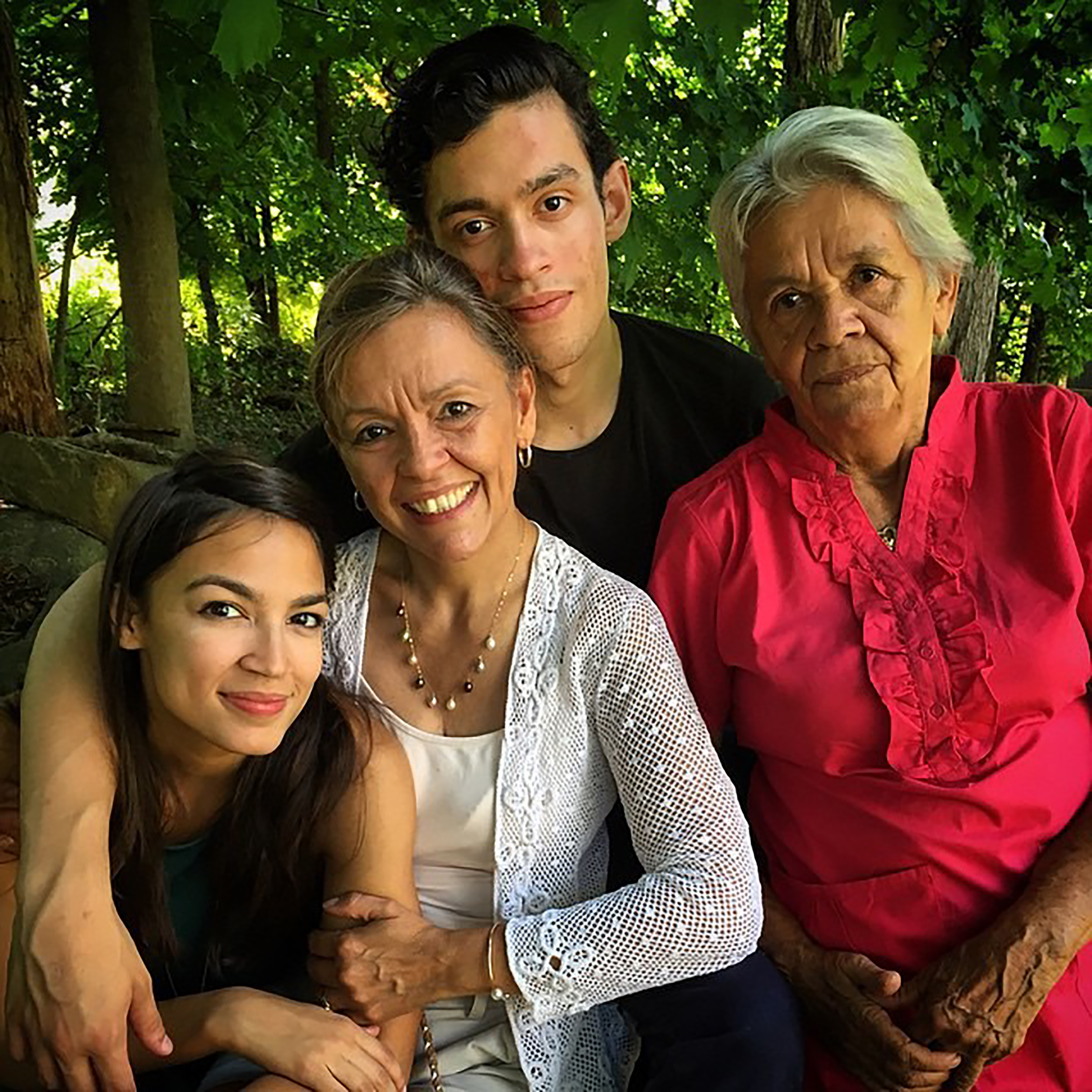
One of Ocasio-Cortez’s first events was at the home of Jake DeGroot, a former theater lighting designer who had been involved in Occupy Wall Street. After hearing Ocasio-Cortez shout over the air conditioner in his living room to fewer than a dozen people, DeGroot joined her campaign, first as a volunteer and then as digital organizing director. Many of her top volunteers were former actors who had gotten involved with politics during the Sanders campaign and now saw organizing as a second career. (The 14th District contains parts of Astoria, Queens, which is nicknamed Actoria because so many actors live there.) That meant her campaign was infused with the imagination that animates all good drama, and a team that knew how to tell a story. -“Theater and politics are very simpatico,” says DeGroot. “Theater done well is politics; politics done poorly is theater.”
More important, there was a shared sense among the young volunteers that they had been screwed. “We were all children of the recession,” say Waleed Shahid of Justice Democrats. “There’s an overwhelming sense that the economic and political system in our country is rigged.”
That’s why young Americans have become increasingly attracted to democratic socialism, which aims to build a stronger social safety net through democratic elections. After Sanders’ rise in the 2016 Democratic primaries, membership in the Democratic Socialists of America (DSA) soared from fewer than 10,000 members in early 2016 to more than 55,000 by 2019. A 2018 Harvard poll found that 39% of young Americans favor democratic socialism, and even young Americans who don’t identify with the movement overwhelmingly support ideas like Medicare for All, tuition-free public college and a Green New Deal. “Every year, young people are ticking a couple points more left,” says John Della Volpe of the Harvard Kennedy School Institute of Politics, who has been tracking youth political attitudes since 2000. “On literally every single question they’re moving left.”
The DSA endorsed Ocasio-Cortez, and young, enthusiastic volunteers stormed her district in the weeks leading up to the election. In the end, she beat Crowley by about 4,000 votes. The upset made her the new face of the young progressive movement. Within weeks, she was traveling the country, speaking to packed rooms and standing ovations as she stumped for candidates in Kansas, Missouri and Michigan. She pointed to her own unlikely victory and Sanders’ insurgent campaign in the 2016 primaries as evidence that progressives could win across the country. “She has this ability to understand a moment and then how to leverage it,” says Rhiana Gunn-Wright, policy director for the left-wing policy shop New Consensus. “She understands that she has a lot of shine right now.”
And yet most of the campaigns Ocasio-Cortez supported ended up losing. Of 78 candidates endorsed by Justice Democrats in 2018, only four nonincumbents won their seats, all replacing other Democrats in deep-blue districts. Organizers argue that losing isn’t really losing, since progressive primary challengers often pull moderate nominees to the left. Still, “America isn’t her district,” says Joel Benenson, a Democratic consultant who advised Obama’s and Clinton’s presidential campaigns and argues that neither party can win if they don’t win moderates. “Democrats shouldn’t take the bait.”

But this is the paradox facing the Democrats: Ocasio-Cortez represents a merging of movement and electoral politics that hasn’t permeated the rest of the party, let alone the rest of the country. The ideas generating the most enthusiasm among the party’s very loud, very online left flank don’t necessarily win elections. Which to some progressives is beside the point. “The point of a message is not to win an election—it’s to change policy, to move things for people, to lead with your ideals,” says Dr. Abdul El-Sayed, 34, who stumped with Ocasio-Cortez in his bid to become governor of Michigan. “Who cares about winning elections?” Indeed, he lost the Democratic nomination by more than 20 points.
When she goes to meetings in her district, Ocasio-Cortez takes notes, hunched over a single-subject notebook as if she were in science class. As soon as she starts speaking, the room changes. In a hot and stuffy education meeting in the Queens neighborhood of Jackson Heights, the crowd stood up and cheered when she took the microphone, then swarmed her afterward to ask for hugs and selfies. At a community board meeting in an Astoria wedding venue, one older board member slept through the entire session, waking up only to click a few pictures of her on his cell-phone camera. Afterward, Ocasio-Cortez crouched to listen to a constituent’s concerns about the rise of anti-Semitism. Her beige heels, slightly scuffed, were a half size too big.
The reception in Washington hasn’t been quite as warm. Ocasio-Cortez is among the most visible of a group of young, left-wing freshman Democrats—-including Representatives Ilhan Omar of Minnesota and Rashida Tlaib of Michigan—who have sparked controversy for their views on everything from impeachment to Israel. Some fellow first-term Democrats welcome the spotlight she brings. “We have this really dynamic rock star who is getting a lot of attention,” says Representative Haley Stevens of Michigan, a co-president of the freshman class. “Why is that a bad thing?” In person, Democratic sources say, Ocasio-Cortez is friendly and respectful, nothing like the firebrand who spars with -critics online. “She’s quiet as a mouse” in caucus meetings, says one congressional source.
Yet the attention she gets has also prompted plenty of grumbling from colleagues. “You could go a day without writing a story about AOC,” groused Representative Mark Pocan, a co-chair of the Congressional Progressive Caucus and a co-sponsor of the Green New Deal.
Many Democrats argue that proposals like the Green New Deal—a nonbinding resolution that won’t become law with Republicans in control of the Senate and the White House—put Democrats in purple districts in a tough spot. Ninety House Democrats have signed onto it. But others who care about climate change are wary of backing a document that contains provisions—like a jobs guarantee—that put off moderates and tee up GOP attacks. At the recent Conservative Political Action Conference, former Trump adviser Sebastian Gorka dubbed the proposal a “watermelon,” because it was “green on the outside, [and] deep, deep communist red on the inside.” Freshman Democrats representing conservative districts, including Representatives Abigail Spanberger of Virginia and Ben McAdams of Utah—have been asked about socialism at their town halls.
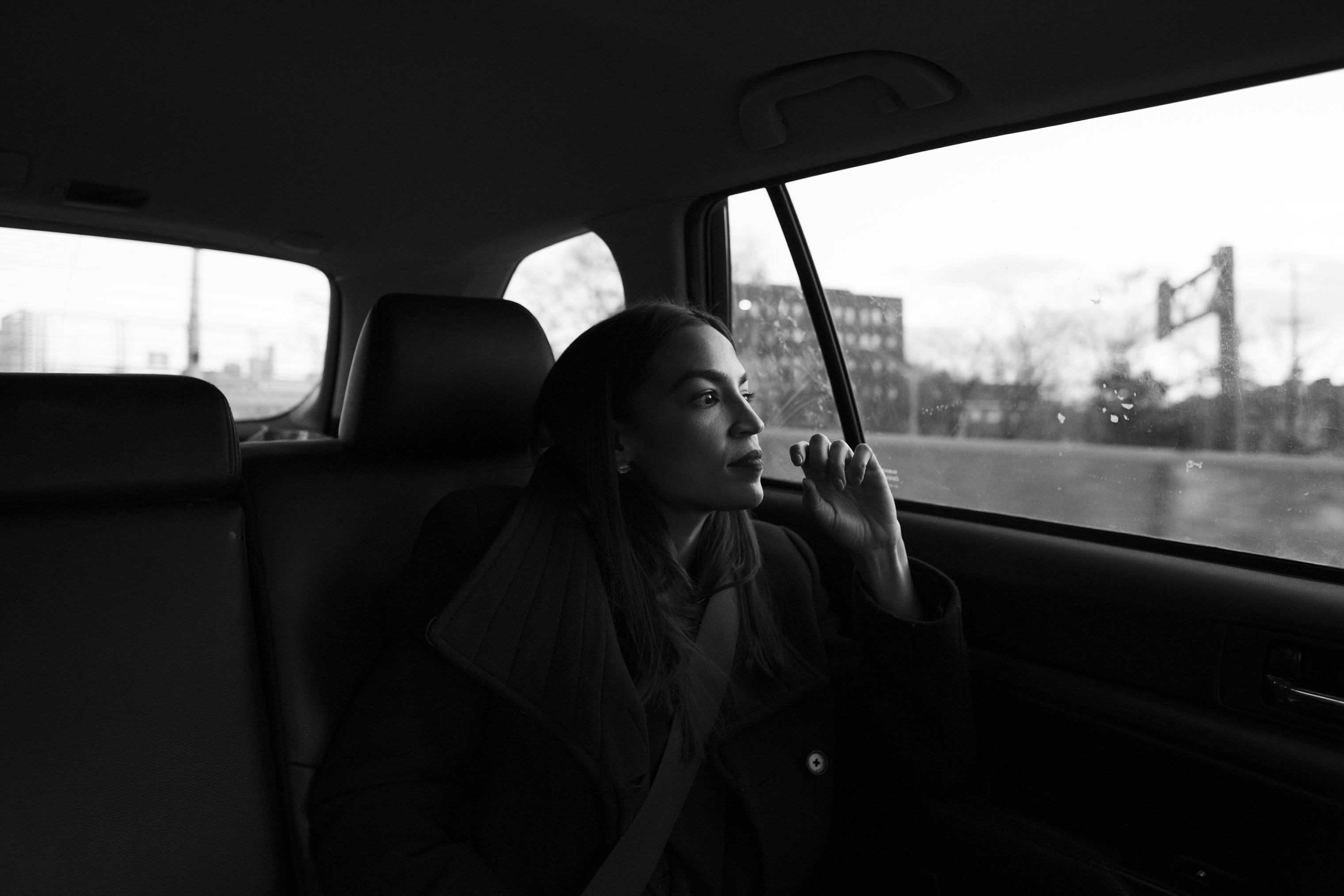
The old adage in Washington is that there are two types of members of Congress-: workhorses who revel in the details of legislating and constituent work, and show horses who crave the cameras. In interviews, a half dozen House Democratic aides described Ocasio-Cortez as the latter. (Her office says she attends more hearings than any of her colleagues.) There’s little question her first months in Congress have included some freshman blunders. Her office botched the rollout of the Green New Deal by inadvertently posting an unfinished version; she took two months longer than any other freshman Representative from New York to open a district office; and conservative groups have filed complaints with the Federal Election Commission alleging improper -campaign-finance arrangements. (Ocasio-Cortez has called the allegations “bogus,” and experts have suggested it’s unlikely her team committed significant campaign-finance violations.) She boosted the grassroots effort to block Amazon’s plan to establish a new hub in New York, but critics say the deal’s collapse cost the city jobs. She sometimes responds to tough coverage—including media outlets pointing out errors she’s made—by firing back at the press. “I think that there’s a lot of people more concerned about being precisely, factually and semantically correct than about being morally right,” she told CNN’s Anderson Cooper.
As an activist, Ocasio-Cortez is used to focusing more on moral imperatives than on incremental policy wins. “I don’t think that we can compromise on transitioning to 100% renewable energy. We cannot compromise on saving our planet. We can’t compromise on saving kids,” she says. “We have to do these things. If we want to do them in different ways, that’s fine. But we can’t not do them.”
Capitol Hill’s traditional emphasis on civility and compromise, she thinks, is merely a delay tactic. “There are always these folks that will say, ‘You’re not wrong, but …’” she says, rolling her eyes. “They avoid the political liability of disagreeing with you, but also they can stall you as much as possible to actually prevent the thing from happening.”
So evaluating Ocasio-Cortez’s success depends on the time frame in which she is judged. Will she help deliver Medicare for All and a Green New Deal in the next two years? No. But having the debate is already making a difference in how D.C. does business. “I used to be much more cynical about how much was up against us,” she says. “I think I’ve changed my mind. Because I think that change is a lot closer than we think.” —With reporting by Alana Abramson/Washington
Charlotte Alter is a National Correspondent at Time.
Krisanne Johnson is a photographer based in New York City.
- The 100 Most Influential People of 2024
- The Revolution of Yulia Navalnaya
- 6 Compliments That Land Every Time
- Stop Looking for Your Forever Home
- If You're Dating Right Now, You're Brave: Column
- The AI That Could Heal a Divided Internet
- Fallout Is a Brilliant Model for the Future of Video Game Adaptations
- Want Weekly Recs on What to Watch, Read, and More? Sign Up for Worth Your Time
